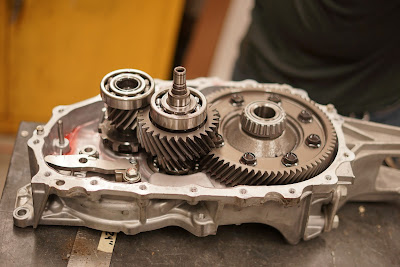Pre-shucking drive unit shot:
Integration is...poor. This makes sense since the Electric Drive was never a high volume vehicle - it was probably a compliance car designed to boost Mercedes' fleet mileage, and relied heavily on subsidies in EV-friendly states to break even.
Donor vehicle's tag, for future reference:
First, a diversion - the air conditioner compressor:
The compressor is fully integrated - DC and CAN in. Internally, it is a scroll compressor:
and an interior PM motor:
with a small inverter mounted to the back. Useful? Unlikely, unless you need an 370VDC air conditioner.
Time to move on to the meatier components. The integrated charger is a 6.6KW unit made by Lear:
Once again, severe coolant draining was required before we could proceed further:
Once the coolant was drained, the charger came off with a few bolts, revealing a nice self-contained unit:
We didn't look further into the charger, as we had minimal interest in turning it on, but it shouldn't be too hard to get running. Of note - the charger doesn't manage balancing, only AC-DC conversion.
Let's look at the inverter next. Aha! A part number! The inverter is an EFP 2-3, made by Continental and sold by Zytek.
A little bit of digging shows that it is a 235A continuous, 355A peak unit. A handful of bolts releases the inverter from the rest of the unit:
Very small and cute. The HV cables probably weigh more than the power electronics.
At this point we had released the motor-gearbox unit from the rest of the drive unit. Already looks promising - nice round motor, practically movable by a single person.
 |
| Hi Charles! |
...we are left with the most adorable little traction motor:
The mounting pattern is very convenient:
Though dangling the 32kg motor off of those tabs is probably less than wise.
The gearbox is almost identical to the Leaf's, just smaller:
Internally, it is very similar:
We attempted to look inside the inverter next. It started out promising:
Oh hey, pin-style channels, presumably to reduce pressure drop.
The HV cable harness is...
...plugged in via giant blade terminals?!
Unfortunately, at this point we were defeated - the inverter housing had some concerning ribbon cables running to the internal boards, and it was very unclear how to split the housing without tearing up the cables.
Overall, this drive unit is very promising for small vehicle conversions. The poor integration is a blessing, as everything has sensible mounting holes, and there's a slim chance that it is possible to acquire the datasheet for the inverter and motor from their respective OEMs. Unfortunately 55/80KW (the latter is Bosch's peak rating for the motor) and 200Nm is not enough for a full car conversion - you would need a pair of them to get good power.

















































